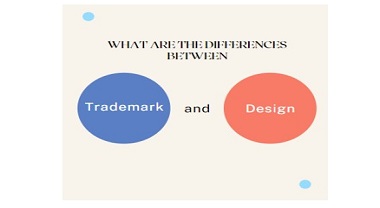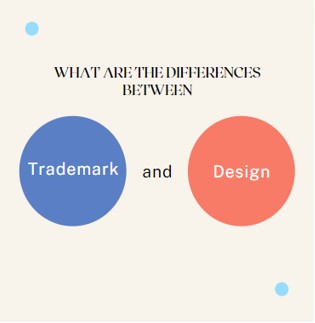Difference Between Trademark And Design Registration In India
Trademark, and design are two very crucial kinds of IPRs which provide a certain extent of protection at their levels. While trademark protects any unique mark which helps in establishing the source of the product, design safeguards the ornamental and aesthetic values of the same which can comprise any composition made by lines, patterns colors, etc, At times, the line between their difference seems to fade and it may get confusing to make an accurate decision between the two. This blog states the key differences between the two which may help you to do the same.
The dominance of Intellectual Property Rights in today’s modern society is to protect their products and organization’s reputation and goodwill, as well as ensure that if a case of violation takes place, they do not suffer considerably huge damage.
There exist several IPRs and it is important to be aware of which one is suitable for your brand/ business. There are added benefits to each IPR that come along with their registration.
Registration is the procedure of filing a particular mark/ name under the respective authority of legal statutes. Registration thus provides legal benefits and protection as well as special exclusive rights to the proprietor of the registered IPR.
As each right has been brought into effect to protect different aspects of Intellectual Property, they have distinctive qualities.
Trademark and design are two of the most important and popular IPRs which can sometimes be confused as the line between their differences may perhaps seem blurry.
They have different provisions and benefits for registration although it is easy to be confused between the two.
The key differences between the two are:
Definition– Trade mark is A trademark is an intangible asset that alludes to any form of visual representation be it a word, symbol or phrase which establishes and distinguishes the products or goods manufactured by a company. There are many types of trademarks such as product marks, shape marks, service marks, certification marks, sound marks, collective marks, pattern marks, etc. It aids in the verification of any source from which the trademark originated, the assurance of product quality, and the protection of the organization’s associated goodwill.
Only the features of a pattern, configuration, shape, decoration, or composition of lines or color, or their combination, applied to a product produced by an industrial process or methods that appeal to the eye are considered design. A design’s designer, creator, or artisan can apply for design registration to safeguard their work from others who would use the same design on their products without authorization.
The governing statutes– Trademark in India is governed by the Trademarks Act, 1999 which is an Act to modify and consolidate trademark legislation, provide for the registration and greater protection of trade marks for goods and services, and prevent the use of false marks.
The Designs Act established in 2000, is the act that governs the rights of a registered design proprietor and remedies available in case of infringement of such violation. There are many more provisions other than those that safeguard the design rights.
Importance of Registration– According to the Trademarks Act, 1999 mark that is capable of being represented graphically and is capable of distinguishing the goods and services of one person from another person can only be considered or registered.
Only aspects of configuration, shape, pattern, or decoration applied to a product which may be two dimensional or three dimensional created by any industrial technique or means that appeal to and are judged exclusively by the sight are eligible for design registration.
If a trademark is not registered, legal action cannot be denied as a person may pursue the remedy of passing off action which is a common law of tort.
However, for an individual to enjoy legal protection and perks, the design must be registered under the respective act.
Assessment basis– The trademark registration of the applicant is assessed based on the class and name they select.
In the case of design, during the design registration process, the investigating officer assesses the item’s inventiveness and beauty.
Innovation– A trademark is a symbol, logo, word, phrase, or even a sound mark that identifies a product or service. It does not need to be innovative, but it must be distinct.
Because designs they made or designed by artists or specialists, designs necessitate innovation
It isn’t only a representation; it must be visually appealing to the aticle to which it is applied.
Government authorities– The trademark registration process in India is regulated by the Trademark Registry or Trademark Registration Office.
On the other hand, the Patent Office is in charge of regulating Design Registration.
Both the registrations can be done online as well as offline.
Nature of offense – Infringement of a trademark in India is a punishable offense, meaning that the offender could face both criminal and civil prosecution. It carries a penalty of 6 months to 3 years in prison and a fine of not less than Rs. 50,000 but not more than Rs. 2 lakhs. As a result, the possibility of severe punishment deters people from imitating.
However, when acts of infringement are carried out for commercial gain, the owner of a registered industrial design or a design patent has the right to prohibit third parties from creating, marketing, or importing items bearing or incorporating a design that is a copy, or substantially a copy, of the protected design, with the registered design holder having the option of filing a lawsuit against the infringer, who, if found guilty, will be liable to pay monetary compensation. It does not include any criminal charges against an infringer.
Longevity of existence– Your company’s trademark becomes a valuable and long-lasting asset that may be sold or transferred to earn more revenue and credit value. The trademark is valid for ten years and can be renewed after that time. This process might carry on indefinitely until the liquidation is completed. As a result, a small credit generation in your company’s odds may arise.
In the case of design, though it does create credit value it lasts till 10 years after which it can be renewed for only 5 years afterward.
Exposure to the public– After the assessment has taken place by the examiner in case of any discrepancies in the trademark application, the trademark is published in the Trade Marks Journal for 4 months for the public to become aware. If any person facing implications wants to come forward and object against the trademark can file a complaint by filling the Form TM-O within 4 months of the publication in the Trademarks Journal. Therefore, it is only after the scrutiny of the public that a trademark can be registered, this accredits some authority to the public and provides an added security to make sure any type of infringement doesn’t take place
In the case of design, according to section 7 of the Designs Act, 2000, the Controller shall cause publication of the design’s specified particulars in the manner prescribed as soon as feasible after registration, and the design shall then be exposed to public view.
Statutory rights– A trademark entails several legal safeguards. Thus, all types of trademarks be they registered or unregistered, are certainly protected against violation. The act also provides for an abundant number of exclusive rights granted to a registered trademark proprietor.
There are sufficient legislative rights and exclusive rights of the registered design holders under the Designs Act as well, although they might not be as impactful as a trademark. There are quite a few remedies available in case-relevant information in the documentation is deceptive.
CONCLUSION
Trademark, and design are two very significant IPRs which may be confusing to differentiate between sometimes, Trademark while promoting client interaction or increasing the product’s commercial attractiveness, renders to seek the validity of the source of its origin. However. If a product’s features increase its economic appeal or aesthetic worth, it falls under the scope of design rights. The differences between trademark registration and design registration are now clarified to you. Both of these IPRs provide beneficial advantages in terms of protection as well as growth. Strategic and thought after decisions are significant to be made to take your business to thriving heights. So, I recommend keeping these differences in mind and making the right choice.
Author: Gurveen Kaur – a intern at IP And Legal Filings, in case of any queries please write back us via email at support@ipandlegalfilings.com.




